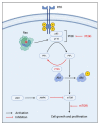New and Emerging Targeted Therapies for Advanced Breast Cancer
- PMID: 35216405
- PMCID: PMC8874375
- DOI: 10.3390/ijms23042288
New and Emerging Targeted Therapies for Advanced Breast Cancer
Abstract
In the United States, breast cancer is among the most frequently diagnosed cancers in women. Breast cancer is classified into four major subtypes: human epidermal growth factor receptor 2 (HER2), Luminal-A, Luminal-B, and Basal-like or triple-negative, based on histopathological criteria including the expression of hormone receptors (estrogen receptor and/or progesterone receptor) and/or HER2. Primary breast cancer treatments can include surgery, radiation therapy, systemic chemotherapy, endocrine therapy, and/or targeted therapy. Endocrine therapy has been shown to be effective in hormone receptor-positive breast cancers and is a common choice for adjuvant therapy. However, due to the aggressive nature of triple-negative breast cancer, targeted therapy is becoming a noteworthy area of research in the search for non-endocrine-targets in breast cancer. In addition to HER2-targeted therapy, other emerging therapies include immunotherapy and targeted therapy against critical checkpoints and/or pathways in cell growth. This review summarizes novel targeted breast cancer treatments and explores the possible implications of combination therapy.
Keywords: HER2; breast cancer; breast cancer treatment; emerging therapies; targeted therapy.
Conflict of interest statement
The authors declare no conflict of interest.
Figures





References
-
- Breast Cancer Facts & Figures 2019–2020. [(accessed on 14 February 2022)]. Available online: https://www.cancer.org/research/cancer-facts-statistics/breast-cancer-fa....
-
- Haque R., Ahmed S.A., Inzhakova G., Shi J., Avila C., Polikoff J., Bernstein L., Enger S.M., Press M.F. Impact of breast cancer subtypes and treatment on survival: An analysis spanning two decades. Cancer Epidemiol. Biomark. Prev. 2012;21:1848–1855. doi: 10.1158/1055-9965.EPI-12-0474. - DOI - PMC - PubMed
Publication types
MeSH terms
Substances
Grants and funding
LinkOut - more resources
Full Text Sources
Medical
Research Materials
Miscellaneous

